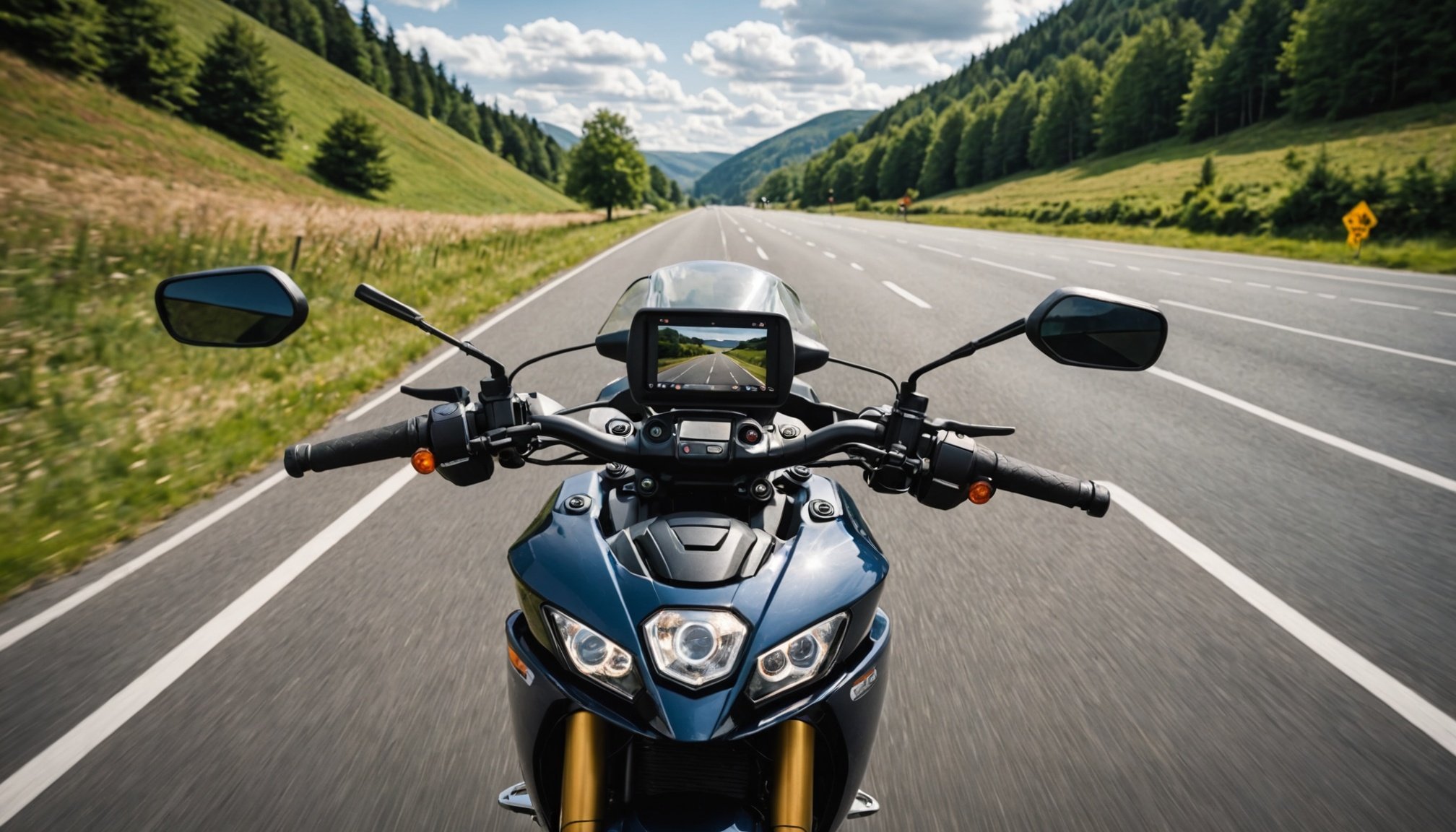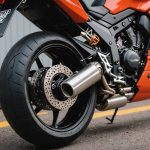Understanding Dash Cameras for Sport Bikes
Dash cameras, or dashcams, have gained popularity among sport bikers for various reasons. A key benefit of dash cameras on sport bikes is the enhancement of safety and accountability on the road. With video recording capabilities, they offer an objective account of events, which can be crucial evidence in case of accidents or disputes.
These devices are typically equipped with advanced technology, such as high-definition video capture, wide-angle lenses, and sometimes even GPS tracking. This ensures that critical details are captured clearly, allowing sport bikers to review their rides and improve their skills. Moreover, dash cameras can deter potential disputes, providing clear evidence of road incidents to insurance companies or law enforcement.
Also to discover : Revamp your sport bike”s exhaust: the ultimate guide to meeting uk noise standards
There are numerous reasons to install a dash camera on a sport bike. Beyond providing evidence in case of accidents, dash cameras can capture memorable rides and scenic routes. For enthusiasts, this is an invaluable feature that extends the benefits of dash cameras beyond security to enjoyment and sharing experiences with others.
Ultimately, installing a dash camera on a sport bike enhances safety by promoting cautious driving and ensuring accountability, making it a wise investment for any serious rider.
Also to discover : Transform your sport bike”s audio for an unforgettable touring adventure in the uk: the complete upgrade guide
Legal Regulations for Dash Cameras in the UK
Understanding the legal framework for dash camera compliance is crucial for sport bikers looking to install these devices. In the UK, several road laws and regulations exist to ensure privacy and proper use of dash cameras.
Overview of Relevant UK Laws
Various regulations govern the use of dash cameras on vehicles. These laws address issues such as the permissible positioning of cameras and the necessity of ensuring that they do not obstruct the rider’s view. Privacy and data protection laws, such as the GDPR, are also relevant, as they dictate how recorded footage should be stored and shared responsibly.
Mandatory Requirements
Motorcyclists should be aware of the required features for dash cameras to comply with UK regulations. This includes ensuring that the devices can handle footage securely and are robust enough to endure various riding conditions. Compliance checks are necessary before installation to avoid issues with legality.
Consequences of Non-Compliance
Failing to adhere to these regulations can result in potential fines and penalties. Moreover, improperly used dash cameras may lead to legal implications regarding the admissibility of footage obtained. Understanding these consequences is essential to maintain safety, accountability, and legality on the road.
Addressing Privacy and Data Protection Concerns
Understanding privacy concerns and data protection laws is crucial when using dash cameras. Under the General Data Protection Regulation (GDPR) in the UK, individuals are protected regarding how their data, including recorded dash camera footage, is processed. This means dash camera users must ensure that footage is stored securely and not shared without consent. Failure to comply with these laws can lead to legal ramifications.
Understanding Data Processing Regulations
Video recording with dash cameras must comply with data protection laws. Sport bikers need to know the rights of individuals captured in their footage. They should only record video necessary for their purpose, minimising excess data collection.
Ethical Considerations
Dash camera users must ensure ethical practices, such as obtaining informed consent when reasonable. Responsible use involves respecting people’s privacy while riding in public and being mindful of filming sensitive areas.
Recommendations for Responsible Footage Use
To responsibly share dash camera footage, adhere to guidelines that ensure privacy laws are not breached. For instance, when using dash camera footage on social media or public platforms, ensure sensitive information is obscured, and personal identities are anonymised whenever necessary. Compliance with these protocols upholds ethical standards and legal obligations.
Step-by-Step Installation Guide
Embarking on the journey of installing dash cameras on sport bikes involves a meticulous approach. The installation process requires specific equipment and attention to detail. Begin by procuring a quality dash camera compatible with your bike model. Essential tools include screwdrivers, mount brackets, and zip ties.
Equipment Needed
Secure a dash camera that has features like high-definition recording and wide-angle lenses. Ensure you also have adequate mounting equipment. This kit might include adhesive mounts or handlebar clips, depending on your chosen camera model.
Installation Steps
- Position the Camera: Choose a spot where the camera view is unobstructed. Typically, a handlebar or helmet mount is favoured.
- Mounting: Use adhesive or clips to attach the dash camera securely.
- Wiring and Power: Connect the camera wiring to a power source. Most sport bikers prefer connecting to the accessory port or battery.
- Testing: After securing, verify the camera’s functionality by recording and replaying a short video.
Avoiding Common Pitfalls
Ensure all connections are stable to avoid the camera dislodging during rides. Regularly check the camera’s alignment and the security of mounts to maintain optimal performance.
Troubleshooting Common Issues
Troubleshooting dash cameras on sport bikes can help riders maintain optimal performance. When facing common issues, understanding how to resolve them quickly is key.
One frequent problem is a camera that won’t power on. Often, the issue stems from a loose connection or a drained battery. Checking the power source and connections should be the first step. If the issue persists, examine the camera’s power button and wiring for defects.
Blurry footage is another common complaint, usually caused by an improperly positioned camera or dirty lens. Adjusting the camera’s positioning or cleaning the lens with a microfiber cloth can enhance video quality.
Audio issues often arise from misconfigured settings or blocked microphones. Ensuring that the microphone is clear of obstructions and checking audio settings can remedy such problems.
If these straightforward troubleshooting methods fail, it might be time to seek professional help. Maintaining an up-to-date camera firmware and conducting regular checks can prevent recurrence. Additionally, consult the camera’s manual or manufacturer support for problem-specific solutions, thus ensuring that the dash camera remains a reliable road companion.
Safety Tips during Installation
When installing dash cameras on sport bikes, prioritising installation safety is essential. Following proper motorcycle safety tips ensures not only a successful setup but also your personal safety during the process.
Safe Working Practices
It’s crucial to observe best practices while handling electrical components. Prior to beginning, disconnect the bike’s battery to prevent electrical shocks. Wear protective gloves to safeguard against accidental cuts or burns. Utilizing insulated tools can help minimise risks when working with wiring. Always ensure you work in a well-lit and clutter-free environment to avoid accidents.
Testing the Installation
Post-installation, verify the dash camera’s functionality. Power on the device and check both visual and auditory recordings. Ensure the camera is securely mounted and that there’s no obstruction in the field of view. Testing under various lighting conditions during a short ride ensures efficient performance before a longer journey.
Regular Maintenance Advice
For optimal performance, regular checks are necessary. Inspect the dash camera monthly for secure mounting and proper functionality. Update firmware when prompted, ensuring the latest features and security patches are installed. Keep the lens free from dust and smudges to maintain video quality, contributing to reliable road documentation.











